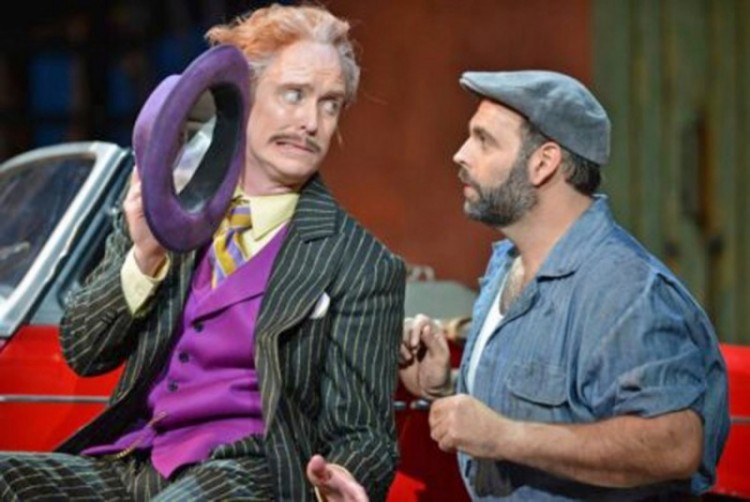
L’elisir d’amore (The Elixir of Love) by Gaetano Donizetti, Opera Philadelphia 2016
This production of The Elixir of Love is funny, and beautifully sung. What more could you want? Well, how about faithfulness to the composer’s theatrical intentions?
Director Stephen Lawless created the production for Santa Fe Opera in 2009 and it certainly is a crowd-pleaser, with amusing action constantly taking place. But the shtick often distracts from the romantic story and from the art of bel canto, “beautiful song.”
That’s a shame, because cast and orchestra were fine in the musical aspects. Sarah Shafer sang with lovely tone and accuracy as Adina and Dimitri Pittas was appealing as the man who is in love with her, while the baritones Craig Verm and Kevin Burdette sang and acted exceptionally well.
Audiences have loved Gaetano Donizetti’s operas for the lovely tunes, and no one has minded that their plots were inconsequential. L’elisir d’amore is set in an 18th-century Basque village where Adina, the owner of a farm, resists the attentions of her socially-inferior peasant neighbor, Nemorino.
He is so desperate that he buys a bottle of alcoholic elixir from a traveling pitchman, hoping that the potion will make Adina fall in love with him. Instead, she flirts with a swaggering army sergeant and even taunts Nemorino by agreeing to marry the soldier. When Nemorino inherits a fortune, all the girls in the village swarm around him, which makes Adina jealous. She then confesses her love for the guy, he attributes the change in his fortune to the elixir, and the opera ends happily.
The setting frequently has been changed to the composer’s homeland, and occasionally has been updated to the 1940s. Lawless located this version at an olive farm in Italy in 1945 at the end of World War II, just as the American army occupied the area.
While some patrons expressed bewilderment at those changes, I was content. Making Adina a schoolteacher instead of a farm owner did no harm, and turning Nemorino into an auto mechanic was clever. His work-cap and overalls marked him as the social inferior he is meant to be.
Instead of the soldiers being Italians, they are American troops, and that’s reasonable. Likewise, I can accept that the character referred to as a sergeant is wearing an officer’s jacket and an officer’s visored hat. He is, after all, the unit commander.
I laughed out loud when a motorcycle was driven onstage during the wedding scene. The biker removed his goggles and his jacket and we saw that this was David Devan, the general director of the opera company, wearing a liturgical stole. He was the priest who was to officiate at the marriage ceremony. This was fine; he had no lines to sing and his appearance didn’t interrupt anyone who was singing.
I’m also willing to overlook the Italian peasants’ incongruous possession of American flags in a village that’s been ruled by Fascists and Nazis for years.
But Lawless’s production added a plethora of other details that were distracting. Almost every phrase was accompanied by busy actions that took attention away from the person who was singing. And when Lawless insisted on turning this charming fluff into an intellectual exercise, he created problems.
For example, the time was specifically 1945, when American and British soldiers occupied Italy. Any cars that Nemorino tinkered with would have to be vehicles made before the war, but he is shown rebuilding an Austen-Healey bug-eye sports car from 1960 with a bonnet from 1965. You can’t avoid noticing this misstep because the car is prominently displayed throughout both acts.
Also, in Act II Nemorino wants to buy a bottle of the elixir but has no money. Belcore offers him a signing bonus if he’ll enlist in the army; Nemorino agrees, takes the money and dons army fatigues. Hello? There’s no way the American army could or would enlist a citizen of the defeated enemy! This threw a major development of the plot into disarray.
It’s unwise to impose tricky, extraneous concepts on a piece that was created to supply simple pleasures. With bel canto opera, the director should start by embracing the style. Then all physical moves should arise from what the lyrics are expressing, not as distractions from the singing.
Pittas stole the show with his expressive delineation of the lovesick Nemorino. His facial and body language were as charming as his singing. He has a sweet leggiero voice, not as aggressive as a Pavarotti.
Shafer, while she sang well, failed to embody the bold and capricious personality of Adina. She is the protagonist of most of the action yet appeared passive, while her simple pink outfit caused her to figuratively blend into the scenery. (On the other hand, I’m glad this director avoided the opposite extreme of top hat and whip which Bartlett Sher specified for Adina in the recent Met production.)
Verm and Burdette projected their comic characters while smoothly navigating the vocal pyrotechnics. Corrado Rovaris led a sprightly interpretation of Donizetti’s score, following the composer’s intentions.
A shorter report appeared earlier in Broad Street Review
Please share your thoughts with us. Address to editor@theculturalcritic.com
Read other reviews on The Cultural Critic